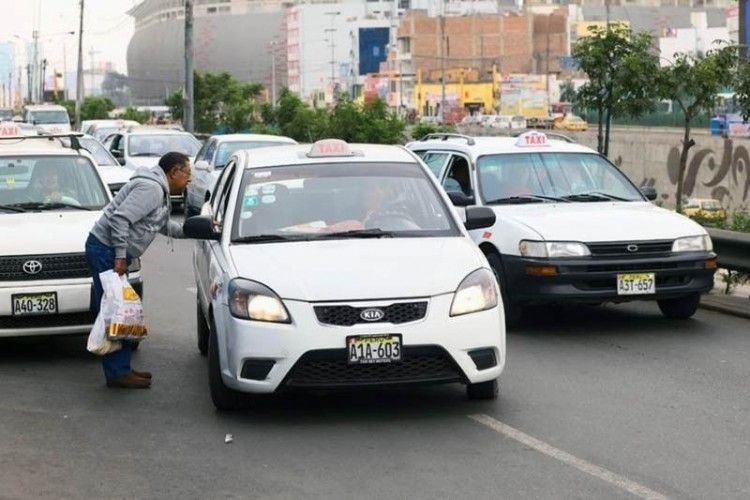Taking a taxi in Lima and other Peruvian cities is a relatively quick and affordable way to get around. But in a strange city with chaotic traffic and lots of warnings and horror stories in mind the first taxi rides might be frightening and overwhelming.
No reason for that, if you are aware of the local situation and follow a few simple rules. And if you really want to be on the safe side, just take a taxi service such as Uber, Cabify or Taxibeat.
Content Overview
Taking a taxi on the street
Finding a taxi in Lima and other Peruvian cities is usually easy. An estimated 180,000 to 200,000 taxis circulate the streets of the Lima-Callao metropolitan area. This is 5 times more per 1,000 inhabitants than the average in Latin American capitals. Other cities in Peru can't complain about a taxi shortage as well. So quite often you don't even have to look for a cab; instead taxi drivers passing by will honk at you and slow down looking for a good fare. If not, just wait at the next bigger intersection and wave when a taxi approaches.
But there are a few things to be aware of before flagging down the first cab you see on the street. Even though lots improved over the past years, today still only an estimated 50% of taxis in the country are official and registered. The rest operates informal, meaning literally everybody can get into any type of car, put a taxi sign on top of it and offer to drive you around the city. Therefore, you should be cautious about which taxi you choose. Below some useful tips and advice on getting safely around by taxi in Peru.
Please note: The following recommendations aren’t supposed to scare you off and shouldn't be considered as contribution to the general hysteria - quite the contrary: they should make you alert for unusual practices and occurrences and help you to avoid or deal with the one or other problem that might occur. While there are a few cons in Lima and other big cities in Peru trying to take advantage of you, there are also thousands of honest and nice taxi drivers, formal and informal. But they normally don't make the news. These hardworking and sometimes highly educated people - you find any profession from policeman to engineer - just want to earn a living by driving you safely around town.
- From and to the airport you should exclusively choose an officially registered taxi, use a taxi remisse or arrange a pickup/drop-off with your hotel.
- For all your other transportation needs, especially if you hail a cap on the street, it is highly recommended to only using officially registered taxis. But how to recognize one? That’s not easy, as regulations aren’t universal in Peru and established by each municipality. So, generally speaking, most taxis you see on Peruvian streets that are available for customers are yellow or white (even though some municipalities allow other colors and colors of other taxi services may vary). Additionally, a good indicator that the taxi you are getting into on the street is legal, is the special taxi license plate which is white with a yellow stripe across the top (here as well not 100% foolproof as some taxi categories don’t need them). Furthermore, officially registered taxis should have a taxi sign fixed on the roof of the car and the license plate number painted (or a sticker) on the side of the car. All drivers of legal taxis are registered with the municipality of their area (in Lima the competent authority is Setame, in neighboring Callao where the airport is located, Setaca) and should have some sort of ID and / or official document proving the registration which you can ask for. Be aware that indicators to identify an officially registered taxi vary and change frequently in Peru and above and below mentioned signs to look for don’t apply to all taxi or other transportation services, but mainly to taxis you can stop on the street. For Lima (in Callao the regulations are a little different) here the exact current requirements taxis have to fulfill. These allow customers to identify the legal ones.
- Taxi Independente (independent taxis): According to municipal regulations independent taxis must be yellow, must have a white license plate with a yellow stripe at the top, have a taxi sign fixed on the roof of the car, have red and white reflective stickers on both sides and rear of the car and the license plate number painted (a sticker is ok as well) on both rear passenger doors. They can stop to pick up or drop off customers anywhere in town, even in the middle of the road. So if you hail down a taxi on the street, it should be one of those.
- Taxi Estación (probably comparable to the old radio taxi): Taxis estación must be white, must have a taxi sign fixed on the roof of the car and have a sticker (painted is fine as well) with the logo and / or company name, contact details and the license plate number on the sides of the vehicle. Next to their intended service of being dispatched to a requested pickup location or from a taxi stand, taxis estación may additionally pick up and drop off passenger anywhere for the service necessary in accordance to traffic and municipal regulations (in reality mostly at intersections of larger roads).
- Taxi Remisse (the luxury version of taxi services): newer cars with AC and other amenities which provide high comfort for the passenger. Taxi Remisse can be of any color, but most are black. No taxi sign, no stickers with information, no other indications that these vehicles are “taxis”; everything discreet. Taxi Remisse aren’t allowed to randomly pick up waving customers on the street. Passengers book via app, webpage or phone with a specific pickup location and drop off destination and drivers are only allowed to pick up / drop off passengers at these points.
- As taxis in Peru usually don't have meters, you must negotiate a price before (!) getting in. After you told the driver where you want to go he will make you a quote. Be prepared that the requested price for foreigners might be a bit higher, but you can try and should bargain. Make sure you understood the price correctly by repeating it adding the word Soles. Some visitors reported when paying the driver, he suddenly asked for the agreed amount in Dollars .... No way, the currency in Peru is Soles, even though most drivers agree to be paid in Dollars (have small notes on you and come to an arrangement before getting into the taxi). Please note that prices during rush hours, early mornings, late at night, on Sundays and public holidays are generally higher (up to 50% more). Anyhow, if you have the feeling you are completely ripped off, send the driver to hell. The agreed fare is only paid once the destination is reached. Occasionally, a driver will stop at a gas station to top up a few liters and might ask to get paid there; if you want to reach your destination, you might want to consider giving him the few Soles for the ride so he can pay his gas. Nevertheless, best have the exact amount on hand! For most drivers, it's already impossible to give change for a 10 Soles note. It's uncommon to tip the driver, but in case he was extremely helpful, 1 Sol or even two surely makes him happy.
- Before getting into a taxi on the street, have a close look at the car and driver. If you have a bad feeling, you feel uncomfortable or something seems off in any way, listen to your gut feeling, send the driver away and take another one. It is highly recommended to not take a taxi on the street at night!
- Never ever get into a taxi where already other supposed to be passengers are seated.
- Don’t accept drinks or food.
- Accusing you of having payed with fake coins or notes is a popular rip-off. After you paid and got out of the taxi, the driver shouts after you, saying you gave him a fake coin or phony bill. Don’t fall for it. While you didn’t pay attention to him, the driver swapped your bill or coin for a faked one, hands it back to you and expects to be paid again. Be very clear that you are aware of his foul play and send him to hell. If necessary, threaten him with Serenazgo (the municipal police) or the tourist police. Walk away.
- Never ever get into a shared taxi!
Too much to remember and feeling confused and wary?
Taxi Services - Uber and others in Peru
If you don't feel comfortable getting a taxi on the street, don't do it. For quite some time now, there are numerous internationally operating taxi services, such as Uber, Cabify, Taxibeat, and others in Peru. As back home, a ride can be easily and quickly booked via their app (or website). Prices are fixed prices (higher than from taxis on the street), cars are usually new(er), clean(er) and well maintained and drivers checked.
Uber operates in Lima, Arequipa, Chiclayo, Cusco and Piura; Cabify (which merged with EasyTaxi) drives you safely around Lima, Arequipa, Chiclayo, Cusco, Piura and Trujillo; Taxibeat is active in Lima, Arequipa and Cusco.
Additionally, there are many recommended and officially registered taxi companies, some with better vehicles than others, some with first class service, some with bilingual drivers, some following all necessary hygiene measures, some cheaper, some more expensive, some you can just call and others offering (also) an app, so the decision which one is the best for you is up to you. Here just a few recommendations in Lima: Taxi Satelital, Alo Taxi, Taxi Movil, Taxi San Borja, Lady's Taxi and at the airport (but bookable as well for getting around town) Mitsui Taxi Remisse and Taxi Remisse CMV.
Some last safety advice ...
While we never had a single problem anywhere in Peru when hailing a random taxi on the street or using a taxi service, locals and a few tourists have enough stories to tell about thefts and even the one or other violent crime (a few are unfortunately true, others seem exaggerated or can't be verified).
Anyway, as it's unfortunately not uncommon, especially on the main road from and to the airport in Lima, that crooks wander around vehicles stuck in traffic jams or waiting at a red light looking out for passengers having any valuables in sight., then smashing the window of the car and grabbing whatever they can out of the car, our last advice:
- Your money, valuables and important documents should be in your pockets or a money belt hidden under your clothes.
- Luggage and other bigger bags or other items should be in the locked trunk.
- Smaller items such as handbags, backpacks, cameras, laptops, iPads, etc. should be placed on the floor, not next to you on the seat.
- To make it difficult smashing the window, slightly open it.































